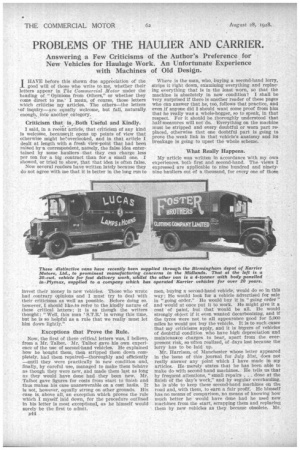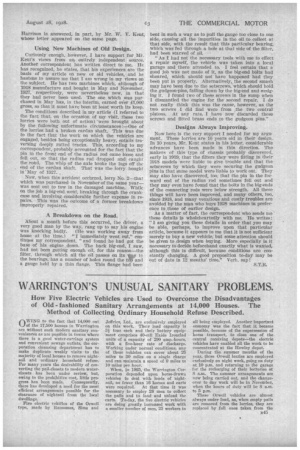PROBLEMS OF THE HAULIER AND CARRIER.
Page 28

Page 29

If you've noticed an error in this article please click here to report it so we can fix it.
Answering a Few Criticisms of the Author's Preference for New Vehicles for Haulage Work. An Unfortunate Experience with Machines of Old Design.
1 I HAVE before this shown due appreciation of the good will of those who write to me, whether their letters appear in The Commercial Motor under the heading of "Opinions from Others," or whether they come direct to me," I medn, of course, those letters which criticise my articles. The others—the letters *of inquiry—are equally welcome, but fall, naturally
enough, into another category. _ •
Criticism that is -Both Useful and Kindly.
I said, in a recent article, that criticism of any kind is welcome, becauselit opens up points of view that otherwise might be,overlooked, and in that article I dealt at length with a fresh view-point that had been raised by a correspondent, namely, the false idea entertained by some hauliers that they can charge less per ton for a big contract than for a small one. I showed, or tried to show, that that idea is often false.
Now several readers have written lately because they do not agree with me that it is better in the long run to
Invest their money in new vehicles. Those who wrote had contrary opinions and I must try to deal with their criticisms as well as possible. Before doing so. however, I should like to refer to the kindly nature of these critical letters; it is as though the writers thought: "Well, this man 8.T.R.' is wrong this time, but he is so helpful as a rule that we really must let him down lightly."
Exceptions that Prove the Rule.
Now, the first of these critical letters was, I believe, from a Mr. Talbot. Mr. Talbot gave his own experience of the use of second-hand vehicles. He explained how he bought them, then stripped them down completely. had them repaired—thoroughly and efficiently —until they were practically in new condition and, finally, by careful use, managed to make them behave as though they were new, and made them last as long as they would have done had they been new. Mr. Talbot gave figures for costs from start to finish and thus makes his case unanswerable on a cost bags. It is not, however, equally strong on other grounds. His case is, above all, an exception which proves the rule which I myself laid down, for the procedure outlined in his letter is most exceptional., as he himself would surely be the first to admit.
1344
Where is the man, who, buying a second-hand lorry, strips it right down, examining everything and replacing everything that is in the least worn, so that the machine is absolutely in new condition? I shall be very surprised if there is another reader of these pages who can answer that he, too, follows that practice, and even if anyone did I should want some proof from him that he really was a whole-hogger, so to speak, in that respect. For it should be thoroughly understood that half-measures will not do. Everything on the machine must be stripped and every doubtful or worn part replaced, otherwise that one doubtful part is going to prove the weak link in that vehicle's anatomy and its breakage is going to upset the whole scheme.
What Really Happens.
My article was written in accordance with my own experiences, both first and second-hand. The views I expressed are applicable to nine hundred and ninetynine hauliers out of a thousand, for every one of those
men, buying a second-hand vehicle, would do so in this way : He would look for a vehicle advertised for sale in "going order." He would buy it in "going order" and would at once put it to work. He might give it a coat of paint, but that would be all. Be would strongly object if it even wanted decarbonizing, and if the tyres were not to all appearance good for 5,000 miles he would not buy the vehicle. It is to such cases that my criticisms apply, and it is buyers of vehicles of doubtful condition who have high depreciation and maintena*ce charges to bear, apart from the everpresent risk, so -often realized, of days lost because the lorry has to be laid up.
Mr. Harrison,-of Manchester whose letter appeared In the issue of this journal for July 31st, does not really answer any point which I have made in my articles. He merely states that he has been able to make do with second-hand machines_ He tells us that by frequent attentions, "small repairs . . . done at the finish of the day's work," and by regular overhauling, he is able to keep these second-hand machines on the road and, with them, to earn a fair profit. He himself has no means of comparison, no means of knowing how much better he would have done had he used new machines from the start, scrapping them and replacing them by new vehicles as they became obsolete. Mr.
Harrison is answered, in part, by Mr. W. V. Kent, whose letter appeared on the same page.
Using New Machines of Old Design.
Curiously enough, however, I have support for Mr. Kent's views from an entirely independent source. Another correspondent has written direct to me. He has recognized, he states, that his experiences are the basis of my article on new or old vehicles, and he hastens to assure me that I am wrong in my views on the subject. He has two machines which, although of 1918 manufacture and bought in May and November, 1927, respectively, were nevertheless new, in that they had never been used. The one which was pur. chased in May has, in the interim, earned o'er £1,000 gross, so that it must have been at least worth its keep.
The conditions described in my article (I referred to the fact that, on the occasion of my visit, these two lorries were both out of action) were brought about by the following unfortunate circumstances :—One of the lorries had a broken cardan shaft. This was due to the fact that the work on which the vehicles are engaged, besides being exceptionally heavy, entails traversing deeply rutted tracks. This, according to my correspondent,.probably accounted for the fact that the pin in the front end of the radius rod came loose and fell out, so that the radius rod dropped and caught the road. The whip of the axle broke the lugs off the end of the cardan shaft. That was the lorry bought it-11'May of 1927. .
Now, when this accident occhrrecl, lorry No. 2—that which was purchased in November of the same year— was sent out to tow in the damaged machine. While on the job a big-end went, breaking through the crankcase and involving considerable further expense in repairs. This was the outcome of a former breakdown improperly repaired.
A Breakdown on the Road.
About a month before this occurred, the driver, a very, good man by the way, rang up to say his engine was knocking badly. (He was working away from home at the time.) "I immediately went out," continues my correspondent, "and found he had got the base of his engine down. The back big-end, I saw, had not been getting enough oil, for this reason—the filter, through which all the oil passes on its IM.ir to the bearings, has a number of holes round the tdil and a gauge held by a thin flange. This flange had beer bent in such a way as to pull the gauge too close to one side, causing all the impurities in the oil to collect at that side, with the result that this particular bearing, which was fed through a hole at that side of the filter, had been starved of oil. • "As I had not the necessary tools with me to effect a repair myself, the vehicle was taken into a local garage and there attended to. I feel certain that a good job was not made of it, as the big-end bolts had sheared, which should not have happened had they been put in properly. Alternatively,, the second smash may have been due to the setscrews, which should hold the gudgeon-pins, falling down by the big-end and wedging it. I found two of these screws in the sump when I .dismantled the engine for the second repair. I do not really think this was the cause, however, as the two screws I did find were from the two central pistons. At any rate, I have now discarded these screws and fitted brass ends to the gudgeon pins."
Designs Always Improving.
Now here is the very support I needed for my argument. These lorries are 10 years old in their design. In 10 years, Mr. Kent states in his letter, considerable advances have been made in this. direction. The makers of this type of chassis probably discovered, early in 1919, that the filters they were fitting in their 1918 models were liable to give trouble and that the setscrews by which they were securing the gudgeon Pins in that same model were liable to work out. They may also have discovered, too, that the pin in the forward end of the radius rod sometimes fell out and they may even have found that the bolts in the big-ends of the connecting rods were below strength. All these things will have been improved, and many others, too, since 1918, and many vexatious and costly troubles are avoided by the man who buys 1928 machines in preference to those of earlier design.
As a matter of fact, the correspondent who sends me these details is wholeheartedly with me. He writes: "I am giving you these details in order that you may be able, perhaps, to improve upon that particular article, because it appears to me that it is not sufficient merely to buy a new vehicle, but some attention should be given to design when buying. More especially is it necessary to decide beforehand exactly What is Wanted, although this is difficult, because conditions are constantly changing. A good proposition to-day may be out of date in 12 months' time." Verb. sap!
































